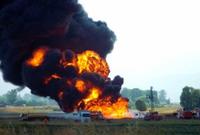-
If South Korea’s nuclear plant staff are vulnerable, then so are the reactors
Does it matter that a South Korean nuclear plant was hacked and plans of the complex stolen? As it is South Korea that’s the subject of this latest attack, everyone tends to assume it must have had something to do with North Korea. With a target as sensitive as a nuclear power plant, not unreasonably people are asking if safety could be compromised by a cyberattack. Could hackers cause the next Chernobyl or Three Mile Island? This points to an important and infrequently discussed problem, the vulnerability of critical national infrastructure. Cyber-attacks like these are a great way of levelling the playing field: why invest in massively expensive nuclear weapons program if you can simply shut down your enemies’ power, gas, water, and transportation systems? Increasingly more and more infrastructure is connected to the Internet, with all the security risks that entails.
-
-
Obama signs five cybersecurity measures into law
Last week President Barack Obama signed five cybersecurity-related pieces of legislation, including an update to the Federal Information Security Management Act(FISMA) — now called the Federal Information Security Modernization Act — the law which governs federal government IT security. Other cyber legislation the president signed includes the Homeland Security Workforce Assessment Act, the Cybersecurity Workforce Assessment Act, the National Cybersecurity Protection Act (NCPA), and the Cybersecurity Enhancement Act.
-
-
Helping coastal communities to visualize sea-level rise
As part of the Federal Emergency Management Agency’s (FEMA) initiative to encourage communities to become more aware of the effects of climate change, the agency has awarded Marin County, California a $150,000 grant to engage residents in climate change issues by allowing them to visualize the effects of sea level rise. The grant will pay for two sophisticated viewfinders programed to envision how the landscape will appear in projected sea level rise scenarios, as well as how the landscape appeared in the past.
-
-
L.A. water supply vulnerable to disruption by earthquakes
Eighty-eight percent of Los Angeles’s water comes from the Colorado River, Owens Valley, and the Sacramento-San Joaquin River Delta, passing through three major aqueducts and into the region. The aqueducts cross the San Andreas Fault a total of thirty-two times, making them vulnerable to the much anticipated Big One.A large temblor on the fault could destroy sections of the aqueducts, cutting off the water supply for more than twenty-two million people in Southern California.
-
-
Placing people in affordable homes within days, not years, after major storms
On Monday, Housing and Urban Developmentsecretary Julian Castro toured the core of a house in Brownsville, Texas, as part of the RAPIDO project, which local officials hope will one day become the model for housing recovery after a major storm. The house is part of a $2 million pilot project which relies on low construction expenses and affordable labor to get people in affordable homes within days of a major disaster instead of years. While hundreds of affordable homes have been built since Hurricane Dolly and Ike destroyed a vast portion of the Texas Gulf Coast in 2008, many residents are still waiting for houses already funded with federal disaster money.
-
-
Better forecasts for rain-on-snow flooding
Many of the worst West Coast winter floods pack a double punch. Heavy rains and melting snow wash down the mountains together to breach river banks, wash out roads and flood buildings. These events are unpredictable and difficult to forecast. Yet they will become more common as the planet warms and more winter precipitation falls as rain rather than snow. Mountain hydrology experts are using the physics behind these events to better predict the risks.
-
-
Be prepared: What to do if an asteroid is heading our way

Last month, experts from European Space Agency’s (ESA) Space Situational Awareness (SSA) program and Europe’s national disaster response organizations met for a two-day exercise on what to do if an asteroid is ever found to be heading our way. The exercise considered the threat from an imaginary, but plausible, asteroid, initially thought to range in size from twelve meters to thirty-eight meters — spanning roughly the range between the 2013 Chelyabinsk airburst and the 1908 Tunguska event — and travelling at 12.5 km/s. Teams were challenged to decide what should happen at five critical points in time, focused on 30, 26, 5, and 3 days before and one hour after impact.
-
-
2008 Turkish oil pipeline explosion may have been Stuxnet precursor

The August 2008 Baku-Tbilisi-Ceyhan (BTC) oil pipeline explosion in Refahiye, eastern Turkey, was ruled at the time to be an accident resulting from a mechanical failure, which itself was a result of an oversight by Turkish government’s supervisors. Western intelligence services concluded that the explosion was the result of a cyberattack. According to people familiar with an investigation of the incident, hackers had infiltrate the pipeline’s surveillance systems and valve stations, and super-pressurized the crude oil in the pipeline, causing the explosion.
-
-
Better defense barriers and technologies for better protection against floods
Hurricanes are devastating. Aside from the high, sustained wind speeds, they usually bring with them heavy rain, which can quickly lead to the breaching of flood defenses in susceptible areas. Now, U.S. and U.K. researchers have reviewed hurricane flood defense barriers and technologies with a view to helping engineers find improved designs.
-
-
Coastal defenses could contribute to flooding with sea-level rise
A combination of coastal defenses and rising sea levels could change typical U.K. tidal ranges, potentially leading to a higher risk of flooding, say scientists. The researchers wanted to find out how tides around the United Kingdom might respond to changes in sea level over the next century depending on the level of coastal defenses in place. Their study shows for the first time that local coastal defenses, such as sea walls, could cause tides to change dramatically. It suggests flood defenses need to be reassessed on an international scale as they may lead to an increased risk of flooding.
-
-
FBI moves cyberthreats to top of law-enforcement agenda
FBI director James Comey said combatting cybercrime and other cyber threats are now top FBI priority. “It (the Internet) is transforming human relationships in ways we’ve never seen in human history before,” Comey said. “I see a whole lot of hacktivists, I see a whole lot of international criminal gangs, very sophisticated thieves,” he added. “I see people hurting kids, tons of pedophiles, an explosion of child pornography.” In October Comey urged Congress to require tech companies to put “backdoors” in apps and operating systems. Such a move would allow law enforcement officials to better to monitor suspected criminals who often escape the law using encryption and anti-surveillance computer software.
-
-
Congressional funding allows partial roll-out of Calif. seismic early warning system
California officials applauded the U.S. Senate approval of the $1.1-trillion spending package, which allocated $5 million to fund expansion of the state’s earthquake early-warning system dubbed ShakeAlert.In 2015, a select number of schools will receive earthquake alerts to warn students and teachers to drop and cover before shaking begins, fire stations will be alerted to open their garage doors before electricity goes out and prevents doors from opening, and some hospitals will receive notice to suspend surgeries.
-
-
Cyber whodunnit: North Korea prime suspect but there are many potential culprits
Many suspect North Korea to be behind the attack on Sony Pictures. North Korea quite possibly has motive, means, and opportunity to carry out this attack on Sony, but as with any successful prosecution, that isn’t enough. We need evidence. We will have to wait for the detailed forensic work to complete before we stand a realistic chance of knowing for certain. That may or may not be forthcoming, but in the meantime we should consider what this event tells us about the balance of power in cyberspace. In a world in which major disruption can be caused with scant resources and little skill, all enemies are a threat. North Korea might be the rogue state that everyone loves to hate but there are plenty of others who could have done it. There is no longer a tiered approach of superpowers fighting proxy wars in smaller, developing nations. Now those developing nations can fight back, and you might not even know it was them.
-
-
Power grids in coastal U.S. cities increasingly vulnerable as a result of climate change
Cities such as Miami are all too familiar with hurricane-related power outages. A new analysis finds, however, that climate change will give other major metropolitan areas a lot to worry about in the future. Johns Hopkins University engineers created a computer model to predict the increasing vulnerability of power grids in major coastal cities during hurricanes. By factoring historic hurricane information with plausible scenarios for future storm behavior, the team determined which of twenty-seven cities, from Texas to Maine, will become more susceptible to blackouts from future hurricanes. The team’s analysis could help metropolitan areas better plan for climate change.
-
-
Impact of solar storm on U.S. infrastructure cannot be predicted with certainty
Of the many threats to the U.S. electric grid, from cyberattacks to terrorism, industry experts agree that the most catastrophic, yet least likely to occur, threat is a magnetic space storm which could shut down the grid and cause other infrastructure to fail. Previous large scale solar storms include the 1859 Carrington Event — the strongest storm on record — and a March 1989 coronal mass ejection which caused a 9-hour blackout in Quebec.
-
- All
- Regional
- Water
- Biometrics
- Borders/Immig
- Business
- Cybersecurity
- Detection
- Disasters
- Government
- Infrastructure
- International
- Public health
- Public Safety
- Communication interoperabillity
- Emergency services
- Emergency medical services
- Fire
- First response
- IEDs
- Law Enforcement
- Law Enforcement Technology
- Military technology
- Nonlethal weapons
- Nuclear weapons
- Personal protection equipment
- Police
- Notification /alert systems
- Situational awareness
- Weapons systems
- Sci-Tech
- Sector Reports
- Surveillance
- Transportation
Advertising & Marketing: advertise@newswirepubs.com
Editorial: editor@newswirepubs.com
General: info@newswirepubs.com
2010-2011 © News Wire Publications, LLC News Wire Publications, LLC
220 Old Country Road | Suite 200 | Mineola | New York | 11501
Permissions and Policies
Editorial: editor@newswirepubs.com
General: info@newswirepubs.com
2010-2011 © News Wire Publications, LLC News Wire Publications, LLC
220 Old Country Road | Suite 200 | Mineola | New York | 11501
Permissions and Policies
